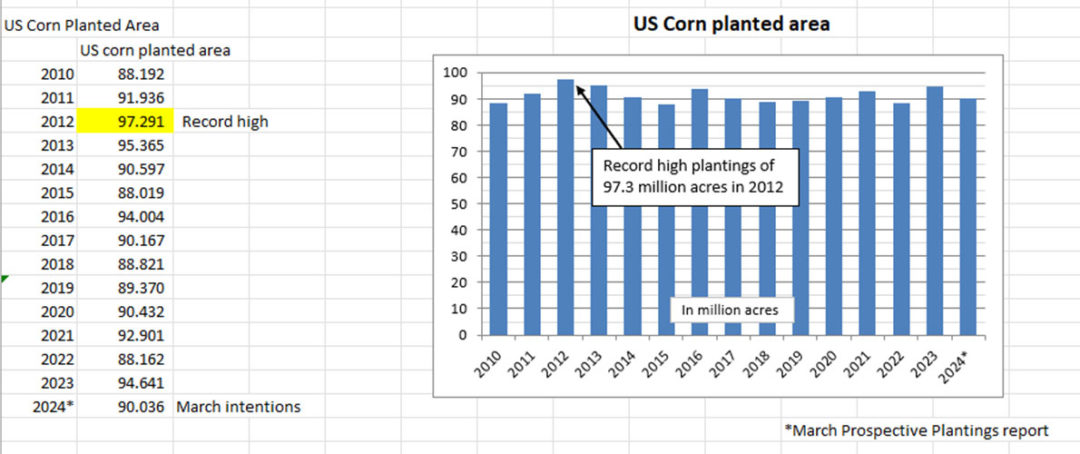WASHINGTON —In its annual Prospective Plantings report March 28, the National Agricultural Statistics Service of the US Department of Agriculture said farmers intend to increase plantings of soybeans this spring compared with a year ago, but seed fewer acres to corn.
The USDA forecast corn planted area at 90,036,000 acres, down 5% from 94,641,000 acres in 2023. The forecast was below the average and near the low end of pre-report trade projections that topped off at about 93.5 million acres and averaged about 91.8 million acres.
If the USDA forecast is realized, the corn planted area in 2024 would be down 7.5% from the record high of 97,291,000 acres in 2012. The recent five-year average corn planted area was 91,101,200 acres.
CME Group corn futures closed up 10¢ to 16¢ a bu across the board after the USDA report. Winter wheat futures also closed higher while Minneapolis spring wheat futures closed lower. Soybean futures also closed mixed with small losses nearby and gains up to 10¢ a bu in the most deferred months.
“Compared with last year, planted acreage is expected to be down or unchanged in 38 of the 48 estimating states,” the USDA said. “Acreage
decreases of 300,000 acres or more from last year are expected in Illinois, Indiana, Iowa, Minnesota, Missouri, Ohio, South Dakota and Texas. The planted acreage in Iowa will be the lowest since 2006. The planted acreage in Montana will be the highest since 1958.”
Bill Lapp, founder and president of Advanced Economic Solutions, Omaha, Neb., said there are a couple things to note about corn acres at 90 million acres.
“No. 1, last year from the March to the June reports, we added 2 million to 3 million acres to that,” Lapp said. “This isn’t the final answer, we could add quite a bit, and the bias would be that direction given corn-soybean acres were that low. And the other thing is if USDA missed by 2 million acres, that’s the equivalent to about two weeks of hot, dry weather in Des Moines (Iowa). Two million acres equates to 4 bus per acre, and we can gain and lose that in pretty quick order in the corn fields based on weather.”
Farmers intend to plant 86,510,000 acres to soybeans this spring, up 3% from 83,600,000 acres in 2023, the USDA said.
The forecast was 20,000 acres below the average of pre-report trade projections that ranged from 85,350,000 acres to 88,000,000 acres.
The record planted area was 90,162,000 acres in 2017. The five-year average soybean planted area was 83,539,800 acres.
“Compared with last year, planted acreage intentions are up or unchanged in 24 of the 29 estimating states,” the USDA said. “Increases of 100,000 acres or more are anticipated in Arkansas, Illinois, Indiana, Iowa, Kentucky, Louisiana, Michigan, Minnesota, Missouri, North Dakota, Ohio and South Dakota.”
A decrease of 180,000 acres seeded to soybeans was expected in Kansas.
Taken together, corn-soybean acres were down 1,695,000 acres, or 1%, from 2023, the USDA said.
“People are befuddled, I’m scratching my head by where the corn acreage and combined corn and soybean acreage ended up,” Lapp said. “To get that much lower is a surprise. USDA might have taken some corn and soybean acres and put it into cotton, since those acres are projected up 4%. The alternative grains such as oats, field peas, mung beans, etc., look more favorable this year.”
The USDA forecast all-wheat plantings for harvest in 2024 at 47,498,000 acres, down 4% from 49,575,000 acres in 2023 but up 4% from 45,769,000 acres in 2022. The USDA projected area by wheat class at 24.3 million acres to hard red winter, 6.26 million acres to soft red winter, 3.59 million acres to white winter, 10.7 million acres to hard red spring and 2.03 million acres to durum wheat.
All-wheat acres were above the average but near the middle of the range of analysts’ pre-report expectations. Winter wheat acres were below the average of analyst expectations, while other spring wheat was higher and durum acres were above the range of expectations, which topped out at 1.8 million acres.
“Wheat acres were a mixed bag,” Lapp said. “When we re-surveyed the winter wheat, we lost a couple hundred thousand acres, but I like the spring number and especially the durum numbers being higher. Those are good signs. Two million acres of durum when you combine US with Canada — we’re going to be swimming in pasta.”
The USDA forecast oats seedings in 2024 at 2,318,000 acres, down 9% from 2,555,000 acres in 2023. However, the USDA clarified that its projection of the area seeded to oats in comparable states was up 1% from 2023 after discontinuing oat estimates for Arkansas, California, Missouri and Oklahoma.
“If realized, the United States planted area will be the lowest on record,” the USDA said. “Record low planted acreage is expected in Ohio and Oregon.”
The USDA said producers intend to plant 2,932,000 acres to all-rice, up 1% from 2,894,000 acres in 2023 and up 32% compared with 2,219,000 acres planted in 2022.
“Arkansas, the largest long grain rice-producing state, is expected to increase long grain acres by 11% from the previous year,” the USDA said. “Compared with last year, medium grain acres are expected to decrease 26% but short grain acres are expected to increase 75%. California, the largest medium- and short-grain rice producing state, is expected to decrease medium-grain planted area by 6% but increase short-grain area by 80% in 2024. If realized, medium-grain planted area in Missouri will be tied for a record high.”





